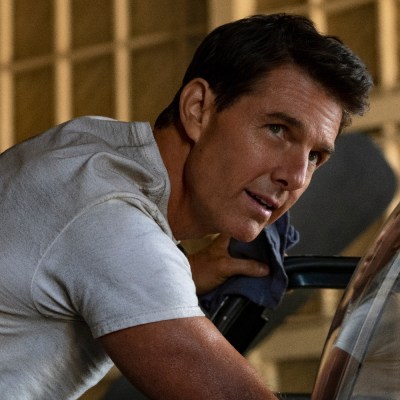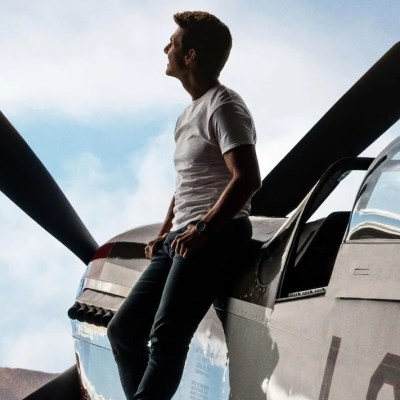Top Gun: How a Single Flight Changed the Course of the Movie
Top Gun screenwriter Jack Epps Jr. tells us what inspired the movie, why his sequel was abandoned, and how a single flight changed Tom Cruise forever.

Screenwriter Jack Epps Jr. took the assignment to write a movie called Top Gun in the mid-1980s for one reason: he wanted to fly in a fighter jet.
“I have my private pilot’s license that I got when I was an undergraduate at Michigan State, so as a private pilot, I said, ‘Well, that’d be fun,’” Epps tells Den of Geek during a recent Zoom chat. “At least I’ll get a jet ride out of it, if nothing else.’”
Epps and his writing partner, the late Jim Cash, got a lot more out of it than that out of Top Gun. The story of a rogue fighter pilot named Pete “Maverick” Mitchell, who joins the Navy’s elite Fighter Weapons School at Miramar base in southern California and must learn the hard way how to fly and fight as part of a team, Top Gun became the highest grossing movie of 1986. It also made a superstar out of rising talent Tom Cruise while influencing decades’ worth of buddy-action films, often set against military backdrops.
The initial idea for the film came from an article called “Top Guns,” written by Ehud Yonay for the May 1983 issue of California magazine, which focused on the lifestyle of the Navy pilots and the personal and professional challenges they faced as they risked their lives every time they took to the skies. The article came to the attention of producing team Jerry Bruckheimer and Don Simpson, who had already scored with hits like Flashdance (1983) and Beverly Hills Cop (1984).
“I was working on Dick Tracy,” recalls Epps about how he and Cash got involved in the project. “Jeffrey Katzenberg was head of production at Paramount, and he wanted to basically do another picture with us, because he really liked the script we had done for Dick Tracy. So I had the famous 8 a.m. breakfast meeting with Jeff Katzenberg. He pitched out six ideas, and one of the ideas was Top Gun.”
Epps says that the “Top Guns” article was merely a launching pad for Cash and him to write their own original story.
“The article basically just said that there’s a school, it’s called TOPGUN, the guys have fun, it’s a cool place, that’s all,” Epps recalls. Yet that gave a lot of latitude to Epps and his co-writer, even if only one of them liked to actually be up in the air.
Indeed, for a man about to co-write a movie about jet pilots, Cash did not like to fly at all.
“I said, ‘Don’t worry about it. I’ll fly planes,'” Epps remembers saying. “‘You don’t have to get in the plane. I’ll tell you all about it. Then I met with Simpson and Bruckheimer. One of the things I said to them initially was, ‘I don’t want to do this unless we get the actual planes. If we don’t get the real planes, I’m not interested.’ And they agreed.”
Bruckheimer and Simpson deployed lobbyists from the Motion Picture Academy to get a meeting with high-ranking officials in the Navy and gain their cooperation in making the film. “After a day of meetings there, they agreed to cooperate with us and support the vision we were pitching to them,” Epps says, “and they told me I’d have to ride in a jet, which is what I wanted all along.”
Epps says that doing the research on the ground and in the air was key, with the writer going through some of the same training that the pilots had to undertake. That included having to swim with a heavy pack out of a simulated helicopter crash in the water, and of course going up in the air with the pilots. But Epps, who also interviewed around 25 pilots and Radar Intercept Officers (RIOs) to learn their personal stories, says that the one thing he didn’t get to do was fly in an actual F-14 Tomcat.
“At that time, the F-14 was classified, so I couldn’t even look in the cockpit,” he explains. “So I flew in what they call their aggressor squadron plane, which is an F-5F, and that was an amazing experience. Flying in a Navy jet is like nothing else. You’re off the ground and up there at 10,000 feet in 10 seconds. We went with pilots named Boomer and Hollywood, and they said, ‘We’re not supposed to do this,’ but then they did a bunch of close passes and rollovers and dogfighting while pulling six, seven, eight G’s, gravitational force, which was amazing. We had a blast.”
Epps adds that his experience of flying with the pilots changed his conception of what Top Gun was actually about.
Says the writer, “I called my partner and said, ‘Jim, this is not the movie we thought it was.’ This is a sports movie. These guys are amazing, top-level athletes because you have to be in great shape to withstand all those pressures and to be able to control that. So that became sort of our metaphor—as both of us were athletes in high school and I was in college a little bit—through which we could find our way into the movie to help us personally relate to what they were doing.”
From the start, Epps maintains that he and Cash had Cruise, who was already on his path to stardom at the time thanks to the success of 1983’s Risky Business, in mind for the role of Pete “Maverick” Mitchell.
“I basically dropped the script off to Jerry Bruckheimer and I said, ‘Think Tom Cruise when you read this,’ because we wrote it for Tom,” says Epps. “Tom was in our mind as the perfect young American pilot. He was ascendant in his career, and because Maverick is a bit of a jerk, you need a guy who you’re really going to like even though he’s not acting in his best interest. So two days later, I get a call from Don Simpson, and he said, ‘I will kill to get this movie made.’”
Ironically enough, Epps says that Cruise was initially hesitant to do the movie, although he was eventually persuaded to get involved after getting a chance to fly with the real-life pilots—just as Epps did—an experience that also launched Cruise’s own lifelong interest in flying planes.
“When it was offered to him, he didn’t get it,” says Epps. “So Jerry smartly said to his agent, who wanted him to do it, ‘Why don’t you have Tom go take a flight?’ So they worked it out that he could fly out of Point Mugu. Tom had just finished Legend with Ridley Scott, so he had long hair. He drives up on his motorcycle to the base, and all these Navy guys look at him and they don’t know this guy—-this isn’t the Tom Cruise that we all know today. So they take this long-hair up in the plane, and they just do what they like to do, which is shake him around, and he threw up all over the plane, but he got out and went, ‘I love this. I’ve got to do this!’ So that’s how Tom got involved and hooked on flying.”
Once filming on Top Gun started, Epps and Cash were already involved in the pre-production for their next script, Legal Eagles, with director Ivan Reitman. So they were unfortunately not able to visit the set of Top Gun or participate in any rewrites during the shoot. Epps says that while “a couple of things got cut out,” including a graduation dogfight over the Mojave Desert, the script stayed essentially unchanged. Epps credits late director Tony Scott, for whom Top Gun was just his second film and first commercial success, with bringing the flying sequences to life onscreen.
“Tony Scott should get a tremendous amount of credit for creating a visual style of the fighting and how they did it,” Epps says. “In the original movie, all the dogfighting was choreographed by the TOPGUN pilots. They were using the world’s greatest pilots to choreograph the flights. They set these cameras up on mountaintops over valleys where they could do high speed passes right near the camera. So they really worked out a whole series of carefully choreographed fight sequences with the top pilots in the world flying those sequences. It was really a very rare thing to have happen.”
Although Top Gun was largely panned by critics upon its release, it was an instant smash with audiences and played for almost six months in theaters. Some 47 million tickets were sold in North America alone, with the film grossing $180 million on its home turf and another $177 million internationally. Its global total of $357 million made it the biggest box office hit of 1986.
Although it may seem strange that it took 36 years for a sequel to arrive in the form of the new blockbuster Top Gun: Maverick, Epps says that he and Cash actually penned a follow-up just a few years after the first film’s release.
“We wrote a sequel in the early ‘90s, and then Tom decided to do Mission: Impossible instead, which I think was a good career move,” explains the screenwriter. He adds that the story was set just five years after the first movie and was “a very different type of story,” although he declines to go into further details about the plot since the movie ended up not getting made at the time.
“It took it to a different level of competition,” Epps hints. “We added some female pilots, which was definitely overdue. It was just taking it to a higher level. But Tom moved on, and they were never going to make it without Tom. That’s just all there was to it. By that time they did get to it, Tom had writers he knew and people he had worked with, and that’s how that moved forward.”
Development of a Top Gun sequel began in earnest around 2010 with the involvement of Tony Scott (before his tragic passing in 2012), Bruckheimer, and of course Cruise. The result, Top Gun: Maverick, is not only getting a rapturous reception from fans and even critics but looks set to become one of the biggest films of the year, eclipsing even the mammoth success of its predecessor.
That, no doubt, is certainly due to the way that Top Gun became ingrained in pop culture from the moment it was released with its then-innovative action sequences, themes of loyalty, courage, and loss, and its unabashedly patriotic tone. Epps believes that the original movie was the right film at the right time at that moment in 1986.
“Timing is one of the most important things in the success of anything,” he muses. “I think the timing was perfect. We were exactly the right people to write the script, Don and Jerry were exactly the right producers, Tony Scott was exactly the right director, Tom Cruise was exactly the right star. Then you have all these young actors… whether it’s Meg Ryan or Anthony Edwards, here’s an amazing group of actors. Where we were at that time as a culture when it was released, I think that we hit a deep emotional chord. It all just happened at the right time.”
Top Gun: Maverick is in theaters now.


